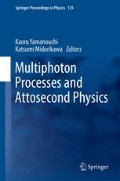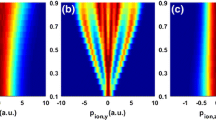Abstract
The timing of electron release in strong field double ionization poses great challenges both for conceptual definition and for conducting experimental measurement. Here we present coincidence momentum measurements of the doubly charged ion and of the two electrons arising from double ionization of Argon using elliptically polarized laser pulses. Based on a semi-classical model, the ionization times are calculated from the measured electron momenta across a large intensity range. This paper discusses how this method provides timings on a coarse and on a fine scale, similar to the hour and the minute hand of a clock. We found that the ionization time of the first electron is in good agreement with the simulation, whereas the ionization of the second electron occurs significantly earlier than predicted.
Similar content being viewed by others
Keywords
These keywords were added by machine and not by the authors. This process is experimental and the keywords may be updated as the learning algorithm improves.
1 Introduction
Among all methods used to measure time, one of the most fundamental approach is to measure the angle of a rotating hand, such as it is done on an analogue watch face. This is the principle used in strong field ionization by the attoclock technique [1]. The rotating electric field vector of a close-to-circularly polarized laser pulse is used to deflect photo-ionized electrons, such that the instant of ionization is mapped to the final angle of the momentum, similar to the minute hand of a clock. The attoclock technique is based on the definition of time by counting cycles [2]. During one period the watch hand completes one cycle, such that measuring the emission angle of the electron enables us to measure time at a precision well below one optical period. Thus the measurement provides attosecond timing without using an attosecond pulse.
2 Results
We used the attoclock to measure the ionization times of the two electrons in double ionization of argon [3]. Due to depletion the averaged ionization time of the electrons is shifted towards the beginning of the pulse with increasing intensity, confirming the results of Maharjan et al. [4]. As a consequence, a multi-cycle measurement is required. Nevertheless, the attoclock technique gives access to two different time scales. First, the magnitude of the electron momenta follows the envelope of the laser pulse and gives a coarse timing for the electron releases (i.e. the hour hand of the clock). Second, the emission angle of the electrons subsequently gives the fine timing (i.e. the minute hand of the clock).
The result of the attoclock measurements addresses a fundamental question in double ionization: are there electron correlation mechanisms, which are not induced by recollision?
Typically people distinguish between sequential double ionization (SDI), where the electrons are assumed to interact independently with the laser field, and non-sequential double ionization (NSDI), where the electrons cannot be treated separately [5]. During the last few years the research focus has been on double ionization by linearly polarized laser pulses with the result that over a wide intensity range the dominating NSDI mechanism is electron impact ionization or excitation at recollision of the first ionized electron with the parent ion, whereas at higher intensities SDI becomes dominant [6, 7].
Still an open question remains whether other mechanisms rather than recollision can occur in strong field double ionization. Elliptically (close to circularly) polarized pulses are ideally suited to answer this question, since recollision of the first emitted electron with the parent ion is prevented. Approaches to high-field ionization problems via classical ensembles recently have predicted NSDI behavior for elliptically polarized laser pulses [8, 9]. Experimental investigations for circular polarization in contrast are rare. An exception is [4], where the structure of the momentum distribution of the double charged ions can be explained both analytically and intuitively as arising from SDI.
We performed experiments on double ionization of Argon with two different laser pulses: a 33-fs laser pulse at a center wavelength of 788 nm and a 7-fs laser pulse from a two-stage filament compressor at a center wavelength of 740 nm and measured the momentum of ions and electrons in coincidence with a COLTRIMS.
The intensity of the 33-fs pulse was adjusted by a rotating half-wave plate followed by a polarizer; the intensity of the 7-fs pulse was tuned by a motorized iris. The measured ratio of \({\mathrm{Ar}}^{++}\) to \({\mathrm{Ar}}^{+}\) ions was used for intensity calibration. The ellipticity was 0.78 for the 7-fs pulse and 0.77 for the 33-fs pulse.
We detect one ion and two electrons in three-particle-coincidence, which means that for each laser shot we select groups consisting of one ion and two electrons out of all detected particles according to the condition \({p}_{\mathit{ion}} + {p}_{\mathit{electron}1} + {p}_{\mathit{electron}2} < 0.3\) a.u., see Fig. 27.1. This ensures that false coincidences are kept low.
3 Conclusion
The ionization time measurement performed with the attoclock (Fig. 27.2) shows that the release time of the first electron is in good agreement with the semi-classical simulation performed on the basis of Sequential Double Ionization (SDI), whereas the ionization of the second electron occurs significantly earlier than predicted. This observation suggests that electron correlation and other Non-Sequential Double Ionization (NSDI) mechanisms may play an important role also in the case of strong field double ionization by close-to-circularly polarized laser pulses.
The coarse estimate for the first (grey) and the second (black) release time for 7-fs (left) and 33-fs (right) laser pulses. The SDI simulation for the first (second) ionization time is shown in grey (black) solid line; for the second ionization different model curves are shown considering different distribution of the five valence electrons over the m quantum states in Ar+. Solid line: equal distribution over the possible m states; dotted line: one electron with \(\vert m\vert \,=\,0\) and four electrons with \(\vert m\vert \,=\,1\), dash-dotted line: 2 electrons with \(\vert m\vert \,=\,0\) and three electrons with \(\vert m\vert \,=\,1\), dashed line: a beating of the two previous configurations with a period of 23.3 fs
References
P. Eckle, M. Smolarski, P. Schlup, J. Biegert, A. Staudte, Schöffler, H.G. Muller, R. Dörner, U. Keller, Attosecond angular streaking. Nat. Phys. 4, 565–570 (2008)
P. Eckle, A.N. Pfeiffer, C. Cirelli, A. Staudte, R. Dörner, H.G. Muller, M. Büttiker, U. Keller, Attosecond ionization and tunneling delay time measurements in Helium. Science 322, 1525–1529 (2008)
A.N. Pfeiffer, C. Cirelli, M. Smolarski, R. Dörner, U. Keller, Timing the release in sequential double ionization. Nat. Phys. 7, 428–433 (2011)
C.M. Maharjan, A.S. Alnaser, X.M. Tong, B. Ulrich, P. Ranitovic, S. Ghimire, Z. Chang, I.V. Litvinyuk, C.L. Cocke, Momentum imaging of doubly charged ions of Ne and Ar in the sequential ionization region. Phys. Rev. A 72, 041403(R) (2005)
A. Becker, R. Dörner, R. Moshammer, Multiple fragmentation of atoms in femtosecond laser pulses. J. Phys. B At. Mol. Opt. Phys. 38, S753–S773 (2005)
Th. Weber, H. Giessen, M. Weckenbrock, G. Urbasch, A. Staudte, L. Spielberger, O. Jagutzki, V. Mergel, M. Vollmer, R. Dörner, Correlated electron emission in multiphoton double ionization. Nature 405, 658–661 (2000)
A. Rudenko, K. Zrost, B. Feuerstein, V.L.B. de Jesus, C.D. Schröter, R. Moshammer, J. Ullrich, Correlated multielectron dynamics in ultrafast laser pulse interactions with atoms. Phys. Rev. Lett. 93, 253001 (2004)
W. Wang, J.H. Eberly, Effects of elliptical polarization on strong-field short-pulse double ionization. Phys. Rev. Lett. 103, 103007 (2009)
F. Mauger, C. Chandre, T. Uzer, Recollisions and correlated double ionization with circularly polarized light. Phys. Rev. Lett. 105, 083002 (2010)
Acknowledgements
This work was supported by the NCCR Quantum Photonics (NCCR QP), a research instrument of the Swiss National Science Foundation (SNSF), by ETH Research Grant ETH-03 09-2 and by an SNF equipment grant. R.D. acknowledges support by a Koselleck Project of the Deutsche Forschungsgemeinschaft.
Author information
Authors and Affiliations
Corresponding author
Editor information
Editors and Affiliations
Rights and permissions
Copyright information
© 2012 Springer-Verlag Berlin Heidelberg
About this paper
Cite this paper
Pfeiffer, A.N., Cirelli, C., Smolarski, M., Dörner, R., Keller, U. (2012). Sequential Double Ionization: The Timing of Release. In: Yamanouchi, K., Katsumi, M. (eds) Multiphoton Processes and Attosecond Physics. Springer Proceedings in Physics, vol 125. Springer, Berlin, Heidelberg. https://doi.org/10.1007/978-3-642-28948-4_27
Download citation
DOI: https://doi.org/10.1007/978-3-642-28948-4_27
Published:
Publisher Name: Springer, Berlin, Heidelberg
Print ISBN: 978-3-642-28947-7
Online ISBN: 978-3-642-28948-4
eBook Packages: Physics and AstronomyPhysics and Astronomy (R0)






